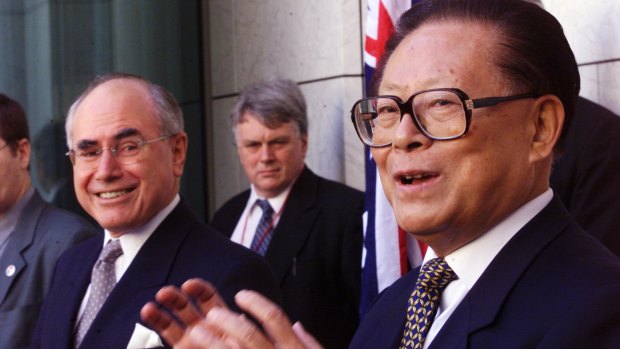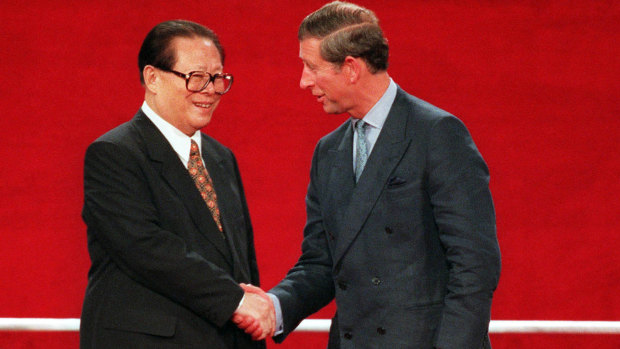Beijing: Former Chinese president Jiang Zemin, who led his country out of isolation after the crushing of pro-democracy protests in Tiananmen Square and supported economic reforms that led to a decade of explosive growth, has died.
Jiang, who was 96, died in Shanghai, state TV reported on its website.
Former Chinese president Jiang Zemin, who has died aged 96, with former Prime Minister John Howard.Credit:Mike Bowers
A surprise choice to lead a divided Communist Party after the 1989 Tiananmen crackdown, Jiang saw China through history-making changes including a revival of market-oriented reforms, the return of Hong Kong from British rule in 1997 and Beijing’s entry into the World Trade Organisation in 2001.
Even as China opened to the outside, Jiang’s government stamped out dissent at home. It jailed human rights, labour and pro-democracy activists and banned the Falun Gong spiritual movement, which it viewed as a threat to the Communist Party’s monopoly on power.
A Chinese man stands alone to block a line of tanks in Tiananmen Square in 1989.Credit:AP
Jiang gave up his last official title in 2004, but remained a force behind the scenes in the wrangling that led to the rise of current President Xi Jinping, who took power in 2012. Xi has stuck to Jiang’s mix of economic liberalisation and strict political controls.
Initially seen as a transitional leader, Jiang was drafted on the verge of retirement with a mandate from then-paramount leader Deng Xiaoping to pull together the party and nation.
But he proved transformative. In 13 years as Communist Party general secretary, the top position in China, he guided China’s rise to global economic power by welcoming capitalists into the Communist Party and pulling in foreign investment after China joined the WTO.
He presided over the nation’s rise as a global manufacturer, the return of Hong Kong and Macao from Britain and Portugal and the achievement of a long-cherished dream: winning the competition to host the Olympic Games after an earlier rejection.
A former soap factory manager, Jiang capped his career with the communist era’s first orderly succession, handing over his post as party leader in 2002 to Hu Jintao, who assumed the presidency the following year.
Jiang was born on August 17, 1926, in the affluent eastern city of Yangzhou. Official biographies downplay his family’s middle-class background, emphasising instead his uncle and adoptive father, Jiang Shangqing, an early revolutionary who was killed in battle in 1939.
Chinese President Jiang Zemin, left, shakes hands with Prince Charles during the handover ceremony of Hong Kong to Chinese rule July 1, 1997. Credit:File
He spoke enthusiastic if halting English and would recite the Gettysburg Address for foreign visitors. On a visit to Britain, he tried to coax Queen Elizabeth II into singing karaoke.
It fell to Jiang, standing beside Britain’s Prince Charles, to preside over the return of Hong Kong on July 1, 1997, symbolising the end of 150 years of European colonialism. The nearby Portuguese territory of Macao was returned to China in 1999.
Hong Kong was promised autonomy and became a springboard for mainland companies to go abroad. Meanwhile, Jiang turned to coercion with Taiwan, the self-ruled island Beijing says is part of its territory.
Jiang had faded from public sight and last appeared publicly alongside current and former leaders atop Beijing’s Tiananmen gate at a 2019 military parade celebrating the party’s 70th anniversary in power. He was absent from a major party congress last month where former leaders are given seats in recognition of their service.
He is survived by his two sons and his wife, Wang Yeping, who worked in government bureaucracies in charge of state industries.
AP
Get a note directly from our foreign correspondents on what’s making headlines around the world. Sign up for the weekly What in the World newsletter here.
Most Viewed in World
From our partners
Source: Read Full Article



